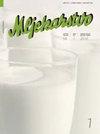Impact of parity on the profile of fatty acids with potential importance for human health in camel (Camelus dromedarius) milk
IF 1.1
4区 农林科学
Q3 AGRICULTURE, DAIRY & ANIMAL SCIENCE
引用次数: 0
Abstract
The aim of the present study was to investigate the influence of parity on the proportion of fatty acids with potential health significance in camel milk fat. Milk samples were collected from four multiparous and four primiparous camels in intensive husbandry at mid-lactation stage. Fatty acid methyl esters were analysed by gas chromatography in conjunction with a flame ionisation detector. Parity had a significant effect on fat and total solids content (p<0.05); mutiparous camels produced milk with lower fat and total solids content. In contrast, protein and ash content were not affected by parity (p>0.05). Primipara camels produced milk richer (p<0.05) in odd and branched chain fatty acids, monounsaturated fatty acids, C17:0, C15:0, omega-3 fatty acids, oleic acid, vaccenic acid and α-linolenic acid, while poorer (p<0.05) for total short-chain fatty acids, total medium-chain fatty acids, total saturated fatty acids, C6:0, C10:0, C14:0, c9-C16:0, C16:0 and iso-C16:0. In addition, the desaturation index for C16, which is an indicator of Δ9-desaturase activity, and the atherogenicity index were lower in primiparous camels (p<0.05). Parity had no effect on conjugated linoleic acid content (p>0.05). Overall, the milk fat of primiparous camels appears to have a relatively high nutritional value, as it contained higher levels of beneficial fatty acids and lower levels of saturated fatty acids.产次对骆驼(Camelus dromedarius)奶中对人类健康具有潜在重要性的脂肪酸的影响
本研究的目的是探讨胎次对骆驼乳脂中具有潜在健康意义的脂肪酸比例的影响。选取集约化养殖的4头产骆驼和4头初产骆驼,在泌乳中期采集乳汁样本。脂肪酸甲酯用气相色谱法结合火焰电离检测器进行分析。胎次对脂肪和总固形物含量有显著影响(p < 0.05);多产骆驼产的奶脂肪和总固体含量较低。相比之下,蛋白质和灰分含量不受胎次影响(p>0.05)。初产骆驼的奇链和支链脂肪酸、单不饱和脂肪酸、C17:0、C15:0、omega-3脂肪酸、油酸、异丙酸和α-亚麻酸含量较高(p<0.05),总短链脂肪酸、总中链脂肪酸、总饱和脂肪酸、C6:0、C10:0、C14:0、c9-C16:0、C16:0和iso-C16:0含量较低(p<0.05)。此外,作为Δ9-desaturase活性指标的C16去饱和指数和动脉粥样硬化指数在初产骆驼中较低(p<0.05)。宇称对共轭亚油酸含量无影响(p>0.05)。总的来说,初产骆驼的乳脂似乎具有相对较高的营养价值,因为它含有较高水平的有益脂肪酸和较低水平的饱和脂肪酸。
本文章由计算机程序翻译,如有差异,请以英文原文为准。
求助全文
约1分钟内获得全文
求助全文
来源期刊

Mljekarstvo
Agricultural and Biological Sciences-Animal Science and Zoology
CiteScore
1.90
自引率
41.70%
发文量
18
审稿时长
12 weeks
期刊介绍:
Mljekarstvo is an open access, peer-reviewed international quarterly scientific journal. The first issue was published in 1951, by the Croatian Dairy Operators'' Association (today: Croatian Dairy Union, publisher). In a paper at a Union conference held 28 October 1951 in Zagreb it was said: "Our desire is that this magazine does not meet the fate of its predecessors, but that it continues to reflect the creative efforts and to provide guidelines for the producers as well as all other operators employed in the dairy industry."
It is our pleasure today to say that wishes of the enthusiasts who attended the conference have come true, and the magazine Mljekarstvo during the last six decades was a reflection of the creative efforts of numerous dairy scientists and experts, and through its texts it served as a guideline in improving production and processing of milk and dairy products. Mljekarstvo has been following all the achievements of the dairy profession in Croatia, and it also gives the short surveys of world achievements. The result of the research of local and foreign scientists and experts always find their place in the magazine Mljekarstvo. It has been edited by our outstanding dairy experts employed at colleges, research institutions and dairy companies.
 求助内容:
求助内容: 应助结果提醒方式:
应助结果提醒方式:


